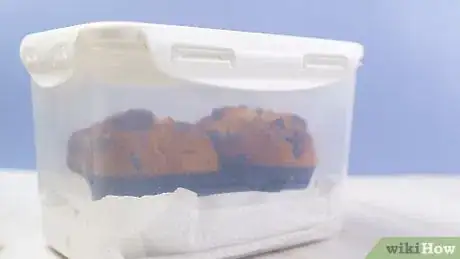This article was co-authored by wikiHow staff writer, Amy Bobinger. Amy Bobinger has been a writer and editor at wikiHow since 2017. She especially enjoys writing articles that help people overcome interpersonal hurdles but frequently covers a variety of subjects, including health and wellness, spirituality, gardening, and more. Amy graduated with a B.A. in English Lit from Mississippi College in 2011 and now lives in her hometown with her husband and two young sons.
The wikiHow Culinary Team also followed the article's instructions and verified that they work.
This article has been viewed 19,339 times.
Learn more...
Homemade muffins are a delicious treat, and they're perfect anytime, whether you're enjoying them for breakfast, an on-the-go snack, or a late-night indulgence. Even better, they're super easy to make yourself! However, after just a couple of days, moisture will start to evaporate from your muffins, leaving the outside soggy and the inside dry. Luckily, you can help slow that process by properly storing your muffins until you're ready to eat them! Keep your muffins in an airtight container at room temperature if you'll be eating them within 3 or 4 days, or freeze them if you want to keep them fresh for up to 3 months.
Steps
Keeping Muffins at Room Temperature
-
1Cool the muffins on a wire rack if they're still warm. When your muffins come out of the oven, transfer them to a wire rack as soon as they're cool enough to handle. The rack will allow air to flow all the way around the muffins, so they'll cool evenly.[1]
- If you put the muffins into a container while they're still warm, the heat will produce condensation, which will then make the surface of the muffins soggy.
-
2Cover the wire rack with a towel to keep the muffins overnight. If you're planning to eat the muffins within about 24 hours, you don't have to put them into a container at all. Just cover them with a layer of paper towels or a clean kitchen towel to keep your muffins fresh and moist until you're ready for them.[2]
- If you think it will be longer than 24 hours before you eat the muffins, you can put them into containers as soon as they're cool.
Advertisement -
3Place the muffins in a paper towel-lined container for up to 4 days. Line the bottom of an airtight container with a layer of paper towels. Then, place a single layer of muffins into the container, and cover the muffins with a second layer of paper towels. The paper towels will help to absorb any condensation that forms, which will help prevent your muffins from getting soggy.[3]
- For best results, use 2 paper towels stacked together on each layer or fold a larger paper towel in half. If you have very thick paper towels, however, a single layer will be fine.
Tip: If you notice the paper towels becoming soggy after a day or two, replace them with fresh ones.
-
4Store your muffins in a cool, dry place. Try to avoid keeping your muffins in a warm or humid spot, like near your stovetop if you'll be cooking. If the muffins get warm in their container, it could cause them to get stale faster. However, don't put them in the refrigerator—the moisture in the fridge will change the texture of the muffins, creating a sticky top and a dry center.[4]
- If you'll be keeping your muffins longer than 4 days, transfer them to the freezer.[5]
-
5Reheat the muffins in a 300 °F (149 °C) oven if you want them warm. While your muffins will be perfectly delicious at room temperature, if you're craving the comfort of another warm muffin after a couple of days, don't fret! Just wrap your muffins in aluminum foil—or put them on a baking sheet covered with foil—and pop them in a preheated oven for about 15 minutes.[6]
- Smaller muffins (about 1 in (2.5 cm) in diameter) will need 12-15 minutes in the oven, while muffins that are 2 in (5.1 cm) or larger will need about 15-18 minutes.
Freezing the Muffins
-
1Place your cooled muffins into a resealable freezer bag. To keep your muffins fresh for longer than a few days, cool them completely, then place them in a plastic freezer bag. Squeeze out as much extra air as you can without squishing the muffins, then seal the bag.[7]
- If you'd prefer, you can wrap the muffins tightly in foil or plastic wrap instead of putting them into a bag.[8]
- You can also use a hard-sided container, but try to pick one that won't leave a lot of extra air around the muffins for the best results.
Tip: Be sure to label the bag or container so you'll remember how long the muffins have been in the freezer!
-
2Keep the muffins in the freezer for up to 3 months. Your muffins will have the best texture and flavor if you eat them within about 12 weeks after freezing. However, they'll still be safe to eat after that—as long as you keep them at a steady temperature of 0 °F (−18 °C), you can store frozen muffins indefinitely.[9]
- Store your muffins near the back of your freezer, where the temperature will remain the most constant.
-
3Thaw the muffins by letting them sit at room temperature for half an hour. There's nothing special you have to do when you want to enjoy a fresh muffin again. Just let them sit on the counter for about 30 minutes to defrost, then either eat them cool or heat them in oven or microwave.[10]
- If you're in a hurry, defrost the muffins by wrapping them in a moist paper towel and microwaving them for 30-60 seconds. After the first 30 seconds, take the muffin out of the microwave and check whether it's heated all the way through.[11]
-
4Wrap the muffins in foil and heat them at 300 °F (149 °C) for a warm treat. For the closest thing to fresh-from-the-oven muffins, wrap them in foil and place them in the oven at 300 °F (149 °C) for about 15 minutes. If you have smaller muffins, they'll need about 12-15 minutes, or around 15-18 minutes for larger muffins.[12]
- For best results, let the muffins defrost completely before you put them in the oven. Otherwise, the center may still be cool when they're finished.
- Try putting a little butter on top of the muffins before you reheat them to help restore some of the moisture that may have been lost during the freezing process.
Things You'll Need
Keeping Muffins at Room Temperature
- Plastic container
- Paper towels
- Dish towel (optional)
Freezing the Muffins
- Plastic freezer bag
- Foil or plastic wrap (optional)
References
- ↑ https://www.thekitchn.com/the-best-way-to-store-quick-bread-and-muffins-236438
- ↑ https://sherisilver.com/2015/09/22/favor-ette-a-baked-goods-tip/
- ↑ https://www.thekitchn.com/the-best-way-to-store-quick-bread-and-muffins-236438
- ↑ https://www.bhg.com/recipes/bread/storing-muffins-and-quick-breads/
- ↑ https://www.thekitchn.com/the-best-way-to-store-quick-bread-and-muffins-236438
- ↑ https://www.bhg.com/recipes/bread/storing-muffins-and-quick-breads/
- ↑ https://www.thekitchn.com/the-best-way-to-store-quick-bread-and-muffins-236438
- ↑ https://www.bhg.com/recipes/bread/storing-muffins-and-quick-breads/
- ↑ https://www.stilltasty.com/fooditems/index/17741
























































